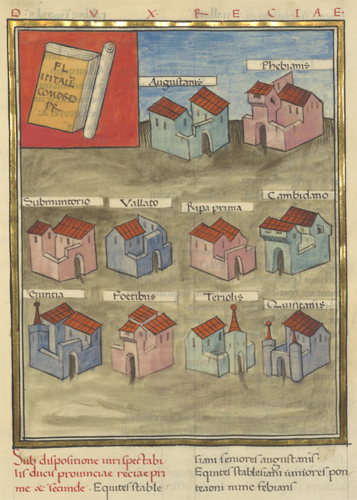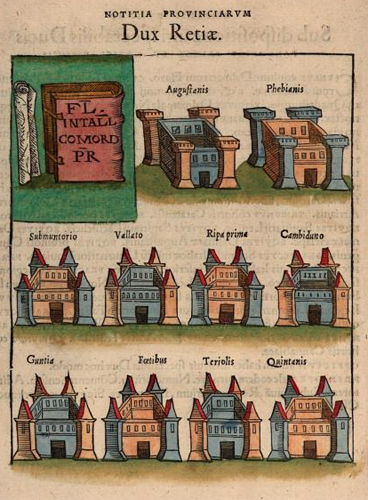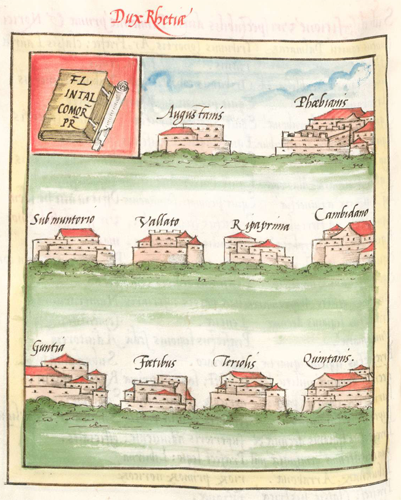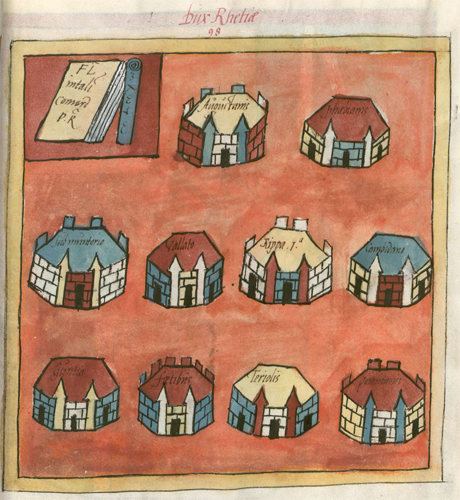
This page created 15 January, 2003, and last modified: 30 December 2015 (emendation commentary added)

 Above: Frontpiece from the Bodleian manuscript (O). The stations depicted are: Augustanis, Phebianis, Submuntorio, Vallato, Ripa prima, Cambidano, Guritia, Foetibus, Teriolis, Quintanis. |
The following units, and tribunes and prefects along with their units, are listed as being under the command of the Dux provinciae Raetiae primae et secundae (i.e. the Duke of first and second provinces of Raetia, corresponding to modern Switzerland; the numbers in front of the names refer to Ingo Maier's numbering scheme):
147.2 Equites stablesiani seniores, at Augustanis |
In addition to the five detachments of Legio III Italica noted above under the Dux, a further detachment is recorded (98/9.111) in the Magister Peditum's infantry roster, and assigned (102/5.104) to the Comes Illyricum. Its shield pattern is as given below:

That under O comes from the Bodleian manuscript in Oxford, that under P from the Paris manuscript, that under M from the first portion of the Munich manuscript, that under W from the second portion of the Munich manuscript, and that under B from the printed Froben edition. This is unlikely to have been the pattern born by the detachments of Legio III Italica still in Raetia, however, as units transferred to a field army from a garrison station seem to have been given new shield patterns. The legion was a creation of Marcus Aurelius in the mid-2nd century, along with it sister unit, Legio II Italica, which in the Notitia is based in neighbouring Noricum.
The men under the Praefectus militum Ursariensium (147.8) might possibly be the same unit as the Ursarienses (102/5.137) of the Magister Equitum in his Gallic command, although a detachment (151.9) with the same name under the Dux tractus Armoricani et Nervicani looks a better bet for that. Given the position of the prefect in the list, sandwiched between detachments of Legio III Italica, it would seem likely his men were also legionaries from the same parent unit. The detachments of Legio III Italica are unusual in that they are not all along the riverine border; some are rather far to the south, guarding the trans-Alpine routes to Italy.
The men under the Praefectus numeri barbaricariorum (147.20) are distinctively named. Firstly, not many units are called numeri in the Notitia; the others are all in Britain. Secondly, barbaricariorum would appear to mean "an embroider working with gold"; although there are several Fabricae (workshops) barbaricariorum mentioned in the civilian sections of the Notitia, its usage as a military name is odd to say the least. More likely, its name here is simply a mistake for numerus barcariorum (cf. 154.6, the Praefectus numeri barcariorum Tigrisiensium), as barcariourum means "bargemen"; this would be a far more apt description for a unit stationed at two locations on Lake Constance. Given the unit's (corrected) name, they probably used the small navis lusoria rather than the larger liburna used by the units stationed on the lower Danube.
The men under the Tribunus cohortis nova Batavorum (147.12) should be more properly called Cohors nonae Batavorum; VIIII Batavorum had been stationed at the location since the mid-2nd century, and a remnant of the unit was apparently still there when the fort fell to the Huns in the 470s, judging by the account in Eugippius' Life of St. Severinus.
Below are shown the frontpieces from the Parisian manuscript, P (and also including some of the following text, in this case); and the Froben printed edition, B:


The stations depicted correspond to the first ten units in the textual list. Below are the frontpiece from the first portion of the Munich manuscript, M; and the picture from the second set of illustrations in the same manuscript, set W.


The Dux' unit list show signs of emendation after the document was first compiled. Firstly, entries 147.3 and 147.5 give two locations each, with the second in each case being prefixed "nunc ("now"). Further, 147.2, 147.3, and 147.4 each describe the unit concerend as being either seniores or iuniores. With the exception of the Milites iuniores Italici (156/8.26) stationed at the westenn Imperial seat of Ravenna, these are the only instances of limitanei units so-called in the Notitia, and may represent a shoring up of defences depleted in the aftermath of invasions of the first decade of the 5th century.
1. Ingo Maier; "Appendix 4: Numeration of the new edition of the compilation 'notitia dignitatum' (Cnd)"; last accessed 7 December 2015. See also for here for numbering examples. Return
2. "Eugippius"; "Vita Sancti Severini" (Life of St. Severinus); 20 ff, available here in Latin and here in English translation (last accessed 27 December 2015). Return

Return to the Notitia index page.